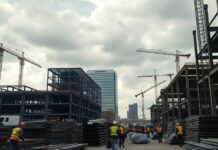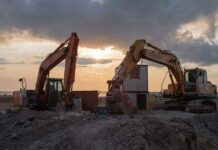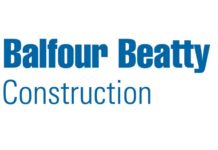The construction sector in the United States is still a key pillar of the country’s economy, propelling innovation and substantial expansion in a number of industries. The most recent industry analysis projects that the U.S. construction market will grow at a compound annual growth rate (CAGR) of 4.4% from 2025 to 2029, reaching an astounding valuation of $1.59 trillion. Despite global concerns, this rising trajectory shows how resilient the business is and how well it can adjust to changing needs in urbanisation, sustainability, and infrastructure development.
The prediction emphasises how important the construction industry is to tackling important issues, such as improving deteriorating infrastructure, increasing the supply of housing, and facilitating the shift to greener and more energy-efficient building techniques. The construction sector is well-positioned to take advantage of opportunities that will shape the economic and social environment of the United States for years to come as the country deals with issues like population increase, climate change, and technology disruption.
Drivers of Growth in the Construction Industry
Both public and private investments are likely to be the main reasons for the U.S. building industry’s strong growth. A big part of this is the strong focus on building up infrastructure, with a lot of money coming from government programs like the Infrastructure Investment and Jobs Act (IIJA). This important law, which aims to rebuild airports, roads, bridges, and public transit systems, sets the stage for the U.S. construction market to grow over the next few years.
The residential construction segment is also a big reason why the business is growing. There is a strong need for new residential buildings because of population growth, trends towards urbanisation, and a chronic housing shortage. Good loan conditions help the housing market, and more and more, developers are using smart technologies and eco-friendly materials in their projects to appeal to customers who care about the environment.
The Role of Sustainability and Innovation
The construction industry in the U.S. is experiencing a significant transformation towards sustainability, influenced by regulatory requirements and the expectations of consumers. The increasing focus on energy efficiency, carbon reduction, and environmentally conscious building practices has resulted in the widespread embrace of sustainable construction techniques and materials. Green building certifications, including LEED (Leadership in Energy and Environmental Design), are increasingly recognised as essential criteria for both public and private projects.
Technological innovation is increasingly transforming the planning, execution, and management of construction projects. The incorporation of cutting-edge technologies, such as Building Information Modelling (BIM), artificial intelligence, and prefabrication methods, is enhancing efficiencies throughout the construction value chain. For example, BIM facilitates collaboration among architects, engineers, and contractors on digital project models, minimising errors and optimising construction schedules. In a similar vein, modular and prefabricated construction techniques are driving down costs, minimising waste, and speeding up project timelines.
Regional Trends and Opportunities
The expansion of the U.S. construction sector varies significantly among states and regions, showcasing distinct local requirements, economic factors, and infrastructure necessities. The Sunbelt region, which includes states like Texas, Florida, and Arizona, remains ahead of other areas in the nation regarding construction activity. The surge in population and positive business environments render these states appealing choices for residential and commercial development alike.
In the meantime, the Northeast and Midwest regions are experiencing significant advantages from extensive infrastructure enhancements, especially in transit systems, bridges, and urban revitalisation initiatives. States such as New York and Illinois are making significant investments in rejuvenating their urban centres to meet contemporary benchmarks of sustainability and technological advancement.
The West Coast, comprising California, Oregon, and Washington, continues to excel in sustainable building practices, emphasising energy efficiency, the incorporation of renewable energy, and initiatives aimed at enhancing climate resilience. Leading technology firms situated in Silicon Valley and various innovation centres are significantly boosting the need for state-of-the-art commercial properties and data facilities.
Challenges Facing the Construction Industry
While the U.S. construction industry presents an optimistic perspective, it is confronted with various challenges that may influence its growth path. One of the main obstacles is the shortage of labour, as an ageing workforce coupled with inadequate recruitment of new talent has led to skill gaps throughout the sector. The sector is diligently tackling this challenge by implementing workforce development programs, launching apprenticeship initiatives, and increasingly embracing automation technologies to enhance human labour.
The availability and cost of construction materials have been significantly impacted by supply chain disruptions, which have been worsened by the COVID-19 pandemic and ongoing geopolitical tensions. Although there have been positive developments in recent months, the industry continues to face risks associated with changes in material prices and logistical challenges.
Delays in regulatory approvals and permitting present significant challenges for executing projects, especially in densely populated urban environments. Successfully manoeuvring through intricate zoning regulations, environmental compliance standards, and community resistance necessitates a thoughtful and cooperative strategy from developers and planners.
The Road Ahead
The U.S. construction industry is set to significantly influence the nation’s economic recovery and tackle the urgent challenges of the 21st century. With stakeholders focussing on infrastructure investment, housing affordability, sustainability, and technological innovation, the growth prospects for the sector continue to look promising.
The anticipated valuation of the U.S. construction market at $1.59 trillion by 2029 underscores the substantial opportunities available for companies ready to adapt and drive the industry into the future. Through the promotion of teamwork, commitment to workforce enhancement, and the utilisation of advanced technologies, the construction industry has the potential to create sustained value for all stakeholders involved, both public and private.
In summary, the construction sector in the United States is poised for a significant period of expansion and change. The sector stands ready to drive economic growth and tackle significant societal issues, grounded in a strong dedication to innovation and sustainability. As the landscape progresses, it will consistently lead the way in crafting a sustainable, resilient, and thriving future for America.
Non-residential building, which includes business, factory, and school projects, is also growing steadily. Warehouse and logistics centre building has gone through the roof thanks to the rise in e-commerce. At the same time, the education and healthcare sectors are putting a lot of money into new, cutting-edge facilities to meet the changing needs of their communities.





























